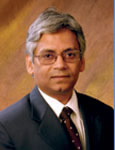Prof. Michael Nikolaou and Kishore Mohanty’s proposals selected by RPSEA for funding
Two University of Houston chemical engineering professors will receive grant funding from the Department of Energy-funded Research Partnership to Secure Energy for America (RPSEA) to pursue research in an effort to increase the nation's supply of energy from unconventional sources, like gas shales and tight gas sands. RPSEA recently selected 19 proposals nationwide, two of which involve chemical engineering professors Michael Nikolaou and Kishore Mohanty, to participate in its Unconventional Resources Program.
Professor Nikolaou is part of an interdisciplinary team that will receive a multi-million dollar award to develop a self-teaching expert system for the analysis, design and prediction of gas production from tight gas reservoirs. The multidisciplinary team (which also includes Lawrence Berkeley National Laboratory and Texas A&M University) proposes to develop a web-based decision-making system that provides its users—exploration and production companies—the ability to mathematically model scenarios and develop predictions that can help them determine where to drill wells for natural gas and how to produce from these wells.
"We need a better to way to produce natural gas from existing national resources," said Nikolaou. "There is a huge amount of natural gas that is trapped in shales that can not be easily moved. We need to find a way to extract it."
According to Nikolaou, the ability to produce natural gas—a major fuel for electricity generation and heating in the U.S.—from domestic resources is becoming increasingly important. Because conventional production from domestic gas reservoirs is diminishing, the U.S. imports an increasing amount of its natural gas supply from overseas in the form of liquefied natural gas (LNG). However, transporting gas as LNG is inefficient—more than a quarter of the transported gas is consumed in the liquefaction/regasification process. The situation could be alleviated if a potentially large supply of gas that exists within the U.S. could be produced from reservoirs like the Barnett Shale in Fort Worth, TX. But this is difficult, says Nikolaou.
"If we could extract the gas from these reservoirs, we would definitely make an impact," he said. "However, despite some early success stories, the extraction process is empirical—there are many factors that affect the outcome and it is very risky. It's a hit-and-miss operation."
Natural gas in shales, known as "tight gas", presents many challenges to exploration and production companies who seek to produce it. The process is often unpredictable and, therefore, quite risky. In order to extract tight gas, companies have to fracture rocks to create "superhighways" for the gas to escape. Exactly how to fracture these rocks in a way to control the flow of gas is a major obstacle, according to Nikolaou, as is displacing the gas with other methods.
"We propose to take all of these variables, along with whatever experience and data producers already have gathered, and create mathematical models to better predict the best location for drilling and what methods to use," he said. "Our goal is to minimize the risks companies have to take."
Another major challenge surrounding the process of fracturing is being addressed in a separate proposal led by Kishore Mohanty, UH professor of chemical engineering. Mohanty seeks to develop ultra-lightweight proppants and non-damaging fracturing fluid to minimize the damage of hydraulic fracturing to gas shale reservoirs. The damage caused hydraulic fracturing often limits the productivity of a well, according to Mohanty, who is teaming up with BJ services and Daneshy Consultants to develop fracture treatments for reservoirs.
"Our goal is to develop foams and fluids that will carry these ultra-lightweight proppants into the reservoir to essentially treat the fracture," he said.
Through a variety of lab and field experiments, the team will first develop non-damaging fluids for gas shale formations and then work with BJ Services to test and evaluate the treatment on operational gas shale reservoirs. According to Mohanty, the successful development of non-damaging fracture treatments will enable the production of huge amounts of natural gas.
The funding details of both proposals are currently being negotiated with RPSEA.

